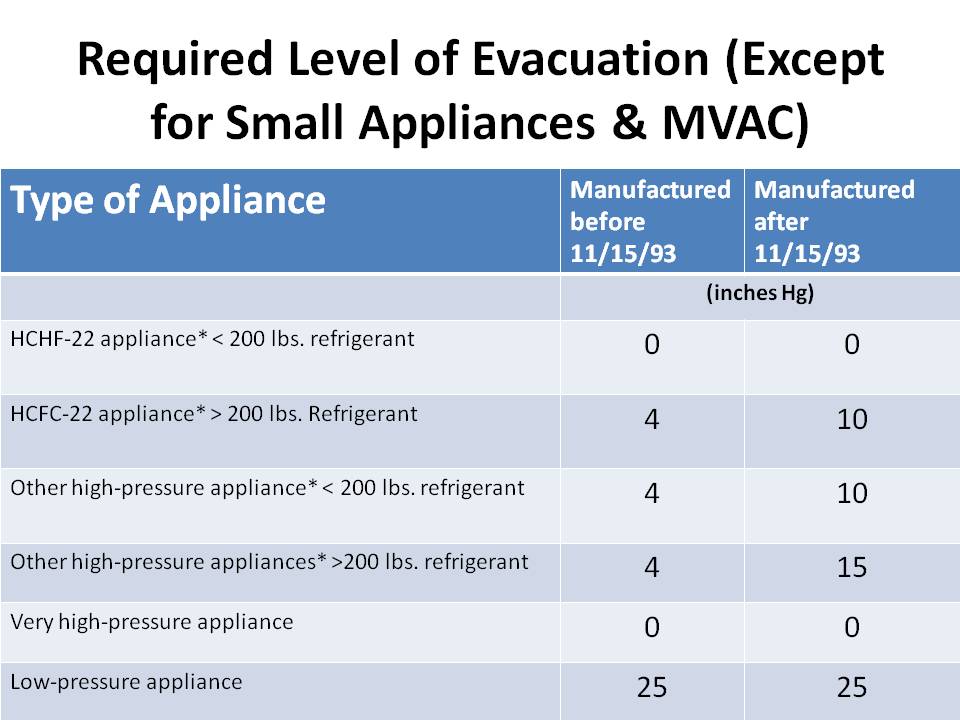HCFC-22. The equipment includes residential air conditioners and heat pumps, supermarket refrigeration and process refrigeration. All residential HVAC technicians will need to be familiar with EPA Type II materials and the EPA Core exam material. Many HVAC techs choose to take their exams one by one as a way to study and concentrate on one exam at a time. Some techs, handymen and repair contractors know that all their business will be from EPA Type 1 kind of work, so they aren’t worried about EPA Type 2 or Type 3.
EPA Type II Certification Exam
Refrigerant Leak Detection and Repair
Refrigeration
Vacuum can be measured in either microns or inches of mercury (inches Hg). The more accurate and preferred method of measuring a deep vacuum is in microns. When evacuating a vapor compression system, the vacuum pump should be capable of pulling 500 microns (or 29.90" Hg) of vacuum. Never start a hermetic compressor when under a deep vacuum as the motor winding could be damaged if energized.
Systems using thermal expansion valves will have a receiver/tank on the outlet side of the condenser, designed to hold liquid refrigerant. When leaving the condenser directly or the receiver, the refrigerant remains a high pressure/high temperature liquid until it goes to the metering device. The line between the condenser and the metering device is also referred to as the liquid line.
Recovery Requirements
- Repairs to leaky equipment. Appliances can be evacuated to atmospheric pressure (0 psig) if leaks make evacuation to the prescribed level unattainable.
- Non-major repairs. Under EPA regulations, a major repair means any maintenance, service or repair involving the removal of any or all of the following components: the compressor, the condenser, the evaporator or an auxiliary heat exchanger coil. A non-major repair would not fall into any of these categories.
Repairs that are not major and that are not followed by an evacuation of the equipment to the environment must be evacuated to at least 0 psig before it is opened if it is a high or very high pressure appliance, or must be pressurized to 0 psig before it is opened if it is a low-pressure appliance.
Recovery Techniques
- Check the service valve positions.
- Check the oil level of the recovery unit.
- Evacuate and recover any remaining refrigerant from the unit’s receiver.
- Evacuate an empty recovery cylinder before transferring refrigerant to the cylinder.
On a routine basis, you should always:
- Check both the oil and filter on a refrigerant recycling machine as recovered refrigerants may contain acids, moisture, and oil.
- Use quick couplers, self-sealing hoses, or hand valves should be used to minimize refrigerant release when hoses are connected and disconnected.
Both recycling and recovery equipment using hermetic compressors have the potential to overheat when drawing a deep vacuum because the unit relies on the flow of refrigerant through the compressor for cooling, so be aware of this problem.
Before charging a new system with refrigerant, technicians working with multiple refrigerants but the same recovery equipment must:
- Purge the recover/recycle equipment by recovering as much of the first refrigerant as possible.
- Change the filter.
- Evacuate.
The only exception to this rule is for technicians working with R-134A, who must provide a special set of hoses, gauges, vacuum pump, recovery/recycling machine, and oil containers to be used with R-134A only.
In order to reduce recovery time and thereby reduce chances for refrigerant emissions, the technician may choose to:
- Pack the recovery cylinder in ice and/or apply heat to the appliance.
- Recover as much as possible in the liquid phase. In order to recover liquid refrigerant, you must connect one hose to the system’s liquid line. After recovering liquid refrigerant, any remaining vapor is condensed by the recovery system.
After recovery, refrigerant may be returned to the appliance from which it was removed or to another appliance owned by the same person without being recycled or reclaimed, unless the appliance is an MVAC or MVAC-like appliance.
You can view practice test questions on the EPA Certification exam here.
EPA's website link on EPA Certification Type II Exam

